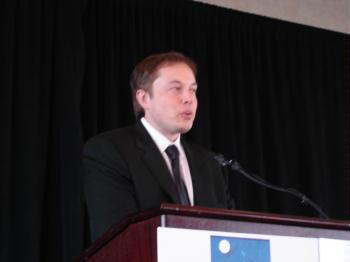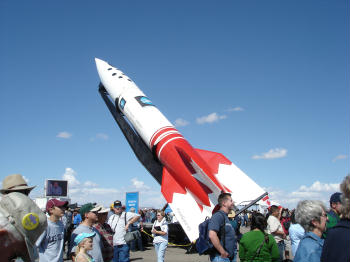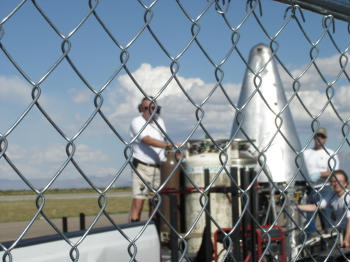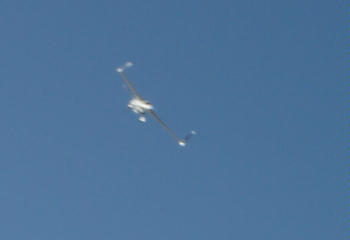We are developing the social individualist meta-context for the future. From the very serious to the extremely frivolous... lets see what is on the mind of the Samizdata people.
Samizdata, derived from Samizdat /n. - a system of clandestine publication of banned literature in the USSR [Russ.,= self-publishing house]
|
SpaceX has been working towards the first launch of its Falcon since late last summer. First they were delayed by a blacksat launch window which caused them to shift operations from Vandenberg to Kwajalein Island. This winter they had the pressurization test accident that caused a fuel tank to crumple.
Everything I have been hearing says this month could finally be it. Best wishes and godspeed to Elon and his crew.
You can download their information pack (just published yesterday) on the upcoming maiden flight from here.
Glenn Reynolds, over at Instapundit, has pointed out this Aviation Week story on the deep black space plane that has been under test at Groom Lake through the last decade.
I have long suspected such a vehicle was flying, partly because of logic. I could not imagine there has been nothing new since the design of the 40 year old SR-71 and the US would retire that fleet of spy planes without someting newer and better. No matter what was said about satellites, they are just not as generally useful and do not have the immediacy of a launch on demand and maneuver on the way aircraft.
I know for a fact that the USAF was studying space planes in the late eighties and early nineties because I knew the guy running the study. It was called Black Horse, an H2O2 fueled aircraft which topped up from a tanker after take off. That officer moved on in to private space but the idea of being able to, as he put it, “put precision holes in the ground anywhere in the world within 90 minutes” was one I assumed had just gone totally black.
Another small piece of information came from a friend with a classified job title back in the early 90’s. A spacer like myself, he told me that his real job would not be public for decades but people would be quite surprised and it was important… and he added that it took him three airplanes, the last of which was a light plane to get to where he worked. I immediately thought of Groom Lake but kept it to myself then and ever since. I have always assumed the Groom Lake sightings were of an at least suborbital SR-71 replacement.
The other item which clued me that something was going on happened last summer. A number of persons I spoke to were pushing a technology called ‘hot structures’ which was about to come out of the black and they were afraid that the technology and all of the money expended on it was about to be lost simply because no one knew it existed. While interesting, it turned out to be far too pricey for anyone I know to employ at this time.
Hot structures have to do with hypersonic airframes of the blended bodies sort. This is stuff you build if you are working on spaceplanes as there is little other use for it. I did not however put the final piece together as AWST did with its far greater resources and contacts. My guess is this technology is about to be lost because the SR-3/XOV is being cancelled.
Does anyone else have any interesting scuttlebutt?
Those of you who follow space will be aware the cornerstone of the ‘Moon, Mars and Beyond’ program which NASA has been tasked to impliment is a new vehicle. The Crew Exploration Vehicle (CEV) is in many ways a return to the Apollo era but does have many useful features, not the least of which is putting the travellers on top. This avoids foam strike problems and at the same time allows the use of proven-in-anger escape tower technology.
It is still a rather old design. Nonetheless it had some features which those of us in the space community apploauded. The biggest win of all was the use of Methane-LOX propulsion. When I read a late draft of the new system plan, this was the single item I found exciting. M-LOX meant someone was serious about going off Earth to stay. It meant someone had read and understood what Bob Zubrin has being saying (perhaps yelling from the prayer town would be a better description) for nearly two decades. You see, M-LOX can be manufactured while sitting on the surface of Mars. The gases of the Martian atmosphere are all you need to manufacture it using a more than century old indstrial process. If you are going to Mars and going to stay, this is the fuel you will use.
That must be why NASA is dropping it although the external excuse is:
Any costs associated with accelerating the five-segmented booster and modified J-2 development programs will be offset in part by dropping plans to develop a liquid-methane fueled engine for the CEV, Hecker said. “From a budget standpoint, it came up as a wash,” he said. “We’re not asking for more dollars.”
NASA is dropping the most important thing they are doing in order to speed up a return to the Moon which will probably be done privately by 2025 anyway.
You may disagree with NASA doing anything at all, but whatever you may desire, they are there. They are a fact of life in the space game. It is much preferable for us to see them waste taxpayer money on something that is at least marginally useful to private sector space ventures.
You can read more discussion on this issue at On-Line Ad Astra, a publication of the National Space Society.
Please excuse any errors as my glasses disapeared whilst transiting Toronto Airport last Thursday and I am writing this by squinting at the screen…
The last of the Lockheed-Martin Titan rockets, after months of slow preparation, is finally up and away from Vandenberg. The blacksat on board was considered quite important and Lockheed used their clout as the launch contractor to kick fledgling rocket company SpaceX out of Vandenberg and away from the pad in which owner Elon Musk had invested millions of his own dollars.
Now that LockMart’s big launch is away they will not have the power to continue their underhanded operations against potentially cheaper competition. A number of folk have told me that Elon’s burn rate has been such that he is no longer quite a billionaire. As the adage goes, the way to make a small fortune in aerospace is to start out with a large one. Nonetheless, Elon is not letting the bastards (at Lockmart) get him down. I believe he has his next test coming up in November on Kwajalein, and the USAF is reportedly quite positive about working with him.
Except when LockMart throws a hissy fit…
 Elon Musk speaking at the National Space Society’s 2005 International Space Development Conference in Washington, DC. Photo: Dale Amon, all rights reserved
If there is a heaven, then I died and went to Las Cruces this weekend. Or perhaps I stumbled into a jackrabbit hole after one of the long sessions in the hotel bar and found myself inside a space art painting I saw some years back. Whatever the case… I was there.
It was obvious from a great distance the event was bigger than I had imagined possible.
 Photo: Copyright Dale Amon, all rights reserved.
Photo: Copyright Dale Amon, all rights reserved.When I noticed the Canadian rebuild of a V-2 missile I decided some Canadians have two. Big ones. Really big ones. Made of solid stainless steel.
And yes, those round things really are view ports for the ‘pilot’.
 Photo: Copyright Dale Amon, all rights reserved.
Photo: Copyright Dale Amon, all rights reserved.I got up close and personal with Burt Rutan’s SpaceShipOne.
 Photo: Copyright Dale Amon, all rights reserved.
Photo: Copyright Dale Amon, all rights reserved.John Carmack pats his Armadillo after it tipped over on landing from a tethered 20 foot controlled flight.
 Photo: Copyright Dale Amon, all rights reserved.
Photo: Copyright Dale Amon, all rights reserved.Your fellow Samizdata readers at XCOR Aerospace brought their EZ-Rocket engine testbed out of retirement just for the event. Astronaut Searfoss jumped at the chance to display this lovely hot-arsed bird twice within the afternoon.
 Photo: Copyright Dale Amon, all rights reserved.
Photo: Copyright Dale Amon, all rights reserved.Even the bicycles had rocket motors on them.
 Photo: Copyright Dale Amon, all rights reserved.
Photo: Copyright Dale Amon, all rights reserved.The British engine gave a rather spectacular pyrotechnic sound and light show as it blew up at t=0. To be fair, the Starchaser group apparently had several succesful firings of this quite large engine over the weekend. I simply had the good or bad fortune to be there for the one that did not.




 Photo: Copyright Dale Amon, all rights reserved.
Photo: Copyright Dale Amon, all rights reserved.I also have video of such things as two low level passes by an F117; the full first flight of EZ-Rocket and much else, but I am afraid I would bring our server to its little knees if I were to try to upload so much to it.
We will just have to get used to bigger storms as we head deeper into the upside of the decades long Atlantic storm cycle. Over the next decade nature will be reclaiming land which became saleable during the downside of the cycle. Unfortunately there are some pretty useful things in threatened areas. One of which is the marvellous Lone Star Flight Museum.
I hope they are getting their airframes out of Dodge and their exhibits to safety. I would hate to see a repeat of what happened to Kermit Week’s collection in Florida about ten years ago.
Tonight I watched the excellent second episode of a BBC series on the US/USSR space race of the 1950’s and 1960’s. I found it highly entertaining and well worth the watching.
As some of you are aware, I have some slight knowledge in this area. It was for the most part well researched and an accurate portrayal both of historical facts and the atmosphere of the time. I found the use of bits of old black and white TV from the period fascinating. I must also admit to recognizing the Life Magazine covers as those and Werner’s Disney appearances had at least something to do with my own passion for space.
This would not be a proper review if I did not also point out what was wrong. The history they presented was what anyone would find by researching the times and accepting the received wisdom about ‘what happened’. There was more to the events of the era than most are aware of even though a great deal of it is no longer classified.
There was more at stake than whether ex-German Werner Von Braun launched the first satellite or not. There was an intelligence sting in progress; perhaps one of the most successful in US intelligence history.
The story began some years earlier with a top secret report on the use of space for military purposes, and in particular for spy satellites. The problem was whether flying an object repeatedly and undeniably over an enemy nation would be taken as an aggressive act. Would satellites be treated the same as Francis Gary Powers and his U2 were treated many years later? That was the sticky point, and the way around it was to make sure the Russians were suckered into doing it first. Once they had established the ‘open skies’ precedent, the US was free to roll out the spy satellites. It was no accident that the technology was ready to go and that many of the early Explorer’s were less than scientific in purpose.
The public response, or ‘blowback’ caught Eisenhower by surprise. He’d accomplished precisely what he had wanted to accomplish but was now publicly on the hook for a missile gap which did not actually exist. Even at the time of the Nixon-Kennedy debates, the Russians did not have a significant number of ICBM’s reliable enough to generate a serious strategic threat to America. LBJ, as a member of a key Senate committee was well aware of the real facts and almost certainly used the fact of their secrecy to his and Kennedy’s political advantage.
Meanwhile, Nixon had to hold his tongue on the issue. Some pundits have suggested this may have caused him to strike back in inappropriate ways a decade later, leading to the Watergate fiasco. Personally I cannot forget that he was a key player in the McCarthy hearings of the early fifties, hearings which ruined many lives and did not uncover any of the real Stalinist moles in the heart of the US government.
I will not hold this against the BBC however. Few are aware of this bit of history and there are many who consider it controversial.
I give the BBC an 8.5 for history and a solid 10 for presentation and entertainment.
I fly a lot and have spent more hours in aircraft and the associated departure lounges than I care to think (don’t get me wrong, I am a regular propellerhead). One thing that really cheeses me off is that creature: The Flight Attendant/Pilot Who Thinks He Is The Next Great Wit. On a recent flight our pilot insisted on mixing up his usual spiel (read the safety instructions, we arrive at X GMT, please fasten your seatbelts) with a sort of annoying, endless attempt at making the whole process funny. You could tell that the passengers were getting restless. One chap sitting behind me shouted out “Don’t give up your dayjob” but it was no good. The jerk went on and on for about 10 minutes before, mercifully, takeoff commenced.
A small plea to any wannabee Bob Newharts out there in the airline business: just fly the goddam plane and shut up.
Okay, I feel better now.
It is hard for someone like me to tell how serious this plan for a completely silent aircraft is. This in particular made me dubious:
Environmental campaigners and people living on flight paths have already welcomed the campaign to build the jet.
“Campaign”? That makes me think that this design is as much politics as technology, a suspicion that is confirmed when I look at the website of the Silent Aircraft Initiative, which is the organisation that is promoting this scheme.
The initiative aims to improve competitiveness in the UK aerospace sector by changing the way research is undertaken, through extensive collaboration with a much wider franchise of stakeholders than ever before. By embracing this larger community, the Silent Aircraft Initiative seeks to produce a truly optimised concept design that contributes to the prosperity of the UK in an environmentally sustainable way.
Well, I suppose it could work. But it all smells to me a bit like a rerun of Concorde, in its very early stage, the stage when they were hustling up public money and political support. There is the same obsessive pursuit of one popular variable, in this case silence, to replace Concorde’s equally narrow focus – with insufficient subsequent regard for either economy or cacophony – on speed. The thing even looks rather like Concorde.
I can find no mention of how extremely inconvenient maintaining this new contraption would surely be, what with the engines being on the top.
Comments anyone? Is this a serious scheme, or just kite flying? Or is it serious, but only at a very early stage? And is that BBC report wrong only in implying that the thing is nearly ready to be built?
Do all generic aircraft designs in their early stages have to be political, one way or another – either paid for wholly by a government or by governments in secret, or else “campaigned” for, out there in the public realm?
It has not been a good last few days in the airline industry. Today, a passenger jet crashed in Venezuela, killing its entire passenger muster of more than 160 people. A Cypriot airliner crashed in Greece at the weekend, killing its entire passenger list and crew. And a few days previously, an Air France plane had a crash near Toronto, but fortunately all the passengers survived.
There is probably no direct connection to all this but it is a harsh reminder that, even in an age of ever-improving safety standards, air travel carries its hazards (and of course that is even before we get to the terror issue). It is also makes me aware that the skies over southern Britain, for example, are crammed with aircraft and it is still amazing that not more accidents occur than is the case. The volume of aircraft now flying to and from Heathrow’s mega-airport is extraordinary and continues to grow. The margins for error when it comes to potential collisions must be razor-thin.
I am on the road once again and sit in an upper Manhattan Starbucks as I write. I face another string of busy days; Saturday morning I fly to San Francisco where I will be doing my usual Wizard of Oz impression as a backstage magician for a JP Morgan technology business conference. Then, after a week of 6am crew calls and 12+ hour workdays, I will be off on a red-eye flight to Washington DC.
In DC I put on my National Space Society hat. Within that organization I am the overseer of conferences, The One Whom All ISDC Chairs Must Fear… which brings me around to why I am writing this article in the first place.
The National Space Society’s 24th International Space Development Conference starts on Thursday May 19th and runs through Sunday afternoon at the Sheraton National Hotel. It looks like it will be quite a show this year.
NASA is running some programming tracks of their own in conjunction with the Society this time around and we also have our usual strong private space showing. Our speakers include such luminaries of the private road to space as Burt Rutan, President of Scaled Composites and SpaceShipOne designer; Dr. Peter Diamandis, Founder and Chairman, X Prize Foundation as well as Chairman and CEO of Zero Gravity Corporation; Will Whitehorn, President of Virgin Galactic; Elon Musk, President of Space Exploration Technologies Corporation; Jim Maser President and General Manager, Sea Launch Company LLC; Jim Benson, Chairman and CEO of SpaceDev; David Gump, CEO of Transformational Space LLC; Eric Anderson, CEO of Space Adventures; Brian Feeney, Team Leader of The da Vinci Project (a Canadian based suborbital space venture); and many more.
But, as the late night TV commercials say, “Wait! There’s more!” This year we have an absolutely unforgettable and unmissable event: a Gala banquet in an exciting location whose management will not allow me to disclose to you. Go through the conference agenda and see where Hugh Downs is speaking. It is a great event and who knows? Maybe you will run into me there.
It is time to Loose The Blogs of War and make some bureaucrat lives absolute hell. It seems the State is being even more annoying than I had imagined possible. I should have known better.
US Government idiocy is delaying Virgin Galactic; it is bureaucratically effing Richard Branson around and it is delaying the time at which you and I will be able to fly into space.
“At this point we are not able to even view Scaled Composites’ designs for the commercial space vehicle,” Mr Whitehorn (Virgin Galactic President) testified before the House committee.
“After US government technology-transfer issues are clarified, and addressed if deemed necessary, we hope to place a firm order for the spacecraft,” he said.
Mr Rutan added that the regulations have already affected financing for the project, which originally was to come from Mr Branson’s London-based Virgin Group.
“We have had to move away from the basic concept of this being a foreign-funded development,” he said.
I myself had believed that a UK company would not be treated so shabbily. As Burt Rutan quipped in a recent US Congressional hearing about commercial space flight:
“I thought Britain was a relatively friendly nation,”
So did I. Brothers-in-arms and all that? Remember who else is in Iraq? Anglosphere and all that rot? Hmmm?
PS: If you can be in the DC area May 19-22, drop by the International Space Development Conference. Burt Rutan and the Virgin Galactic President are both on the program. See you there!
|
Who Are We? The Samizdata people are a bunch of sinister and heavily armed globalist illuminati who seek to infect the entire world with the values of personal liberty and several property. Amongst our many crimes is a sense of humour and the intermittent use of British spelling.
We are also a varied group made up of social individualists, classical liberals, whigs, libertarians, extropians, futurists, ‘Porcupines’, Karl Popper fetishists, recovering neo-conservatives, crazed Ayn Rand worshipers, over-caffeinated Virginia Postrel devotees, witty Frédéric Bastiat wannabes, cypherpunks, minarchists, kritarchists and wild-eyed anarcho-capitalists from Britain, North America, Australia and Europe.
|















